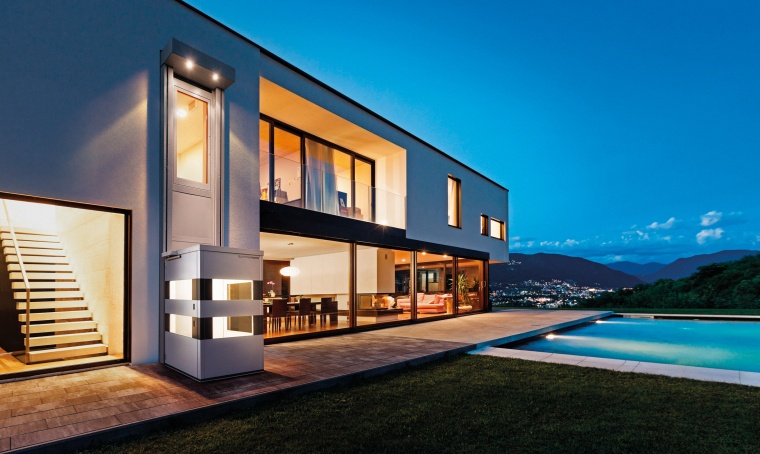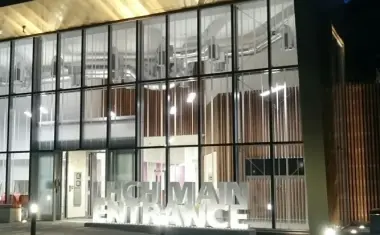Versatile Laser Scanner Makes Affordable Elevators a Reality
With its latest solution a shaftless platform lift Ascendor is offering an affordable elevator model for private households. Rugged laser sensors from SICK protect the freely acc...


With its latest solution – a shaftless platform lift – Ascendor is offering an affordable elevator model for private households. Rugged laser sensors from SICK protect the freely accessible area under the cab.
Statistically, every 72 hours the equivalent of all the world‘s population makes a trip on an elevator. They reliably convey both people and objects of all shapes and sizes into the lofty heights and back down to earth again. In doing so, safety is the topmost priority. Brakes ensure that the cab stops immediately, even if the supporting cable is severed or torn. That also makes this type of lift the safest mode of mass transport in the world – just one reason for its proliferation throughout Europe during the last 150 years.
But since the unveiling of the first hydraulic elevator at the 1867 International Exposition in Paris, technology has seen significant developments. Today we mostly use gearless electrical drive systems for vertical passenger transportation. As they developed, the architectural design of the rapidly growing residential and office building changed too. Skyscrapers then became a reality, with the principal floor of the building moving from the lower stories, easily accessible on foot, to the penthouse with its breathtaking views.
189 stories
Structures such as the Burj Khalifa in Dubai – currently the tallest building in the world – would be unthinkable without elevators. They couldn‘t even be built, let alone inhabited. After climbing just 10 of the 189 stories, the technician whose job it is to maintain the light signaling system (at 829.8 meters) at the top of the tower would be completely out of breath. And the number of visitors to the “At.Mosphere” restaurant, located on the 122nd floor, could most likely be counted on one hand without an adequate means of passenger conveyance.
When the stairs become an obstacle
We have come to appreciate the advantages of elevators – but not just for skyscrapers and buildings more than a hundred stories high. Nobody would wish it on themselves, but even in residences with one or two stories, stairs can quickly become an almost insurmountable obstacle for some – for example, when health-related issues arise. In these cases, an elevator is often the first idea for overcoming the problem, but until now was normally dismissed straight away because the associated structural challenges involved, let alone the enormous costs to the private individual, are seldom feasible. Yet this is precisely where the latest product development from Ascendor comes in, since elevators don‘t always have to be installed in a building‘s interior.
A Lift on the Exterior Wall
If the elevator is built onto the outside of the building, a lot of space is saved and it allows easy mounting without having to make costly structural modifications – a convincing argument particularly for buildings retrofitted with elevator installations or extensions, which would also become significantly more affordable. This idea inspired the engineers at Ascendor GmbH, a company based in Niederwaldkirchen, Upper Austria. The result of their development work is a lift which costs significantly less than conventional elevators in terms of purchase, mounting, and maintenance.
From around 25,000 euros, the “QuattroPorte” shaftless platform lift will carry people to a second or third floor (up to nine meters in height). Because this kind of elevator travels somewhat more slowly and differs from conventional elevator installations in terms of technology, it is primarily the Machinery Directive that is applicable for annual inspection and not the much more stringent requirements of the Lift Directive (the initial technical approval is carried out by means of a type examination by the German Technical Inspection Agency). This is a key advantage of having a lift installed on the outside of a building, as it makes the maintenance affordable for numerous private households.
The Area Under the Cab Can Be Put to Use
Because there‘s no shaft, there is room for the lift in a wide variety of installation scenarios. Door options on all sides enable maximum flexibility during planning. In terms of an electrical supply, a conventional home mains connection (230 V, 16 A, Type C fuse) is sufficient. As far as the design of the cab is concerned, a variety of variants are available in addition to customized models. And the QuattroPorte makes no compromises when it comes to safety, despite the area under the cab remaining usable. But this requires interruption-free monitoring of the ground-floor area, which may be entered by a person or vehicle while the cab is at the top floor – this is where the TiM3xx 2D laser scanners come in, developed by the sensor specialists at Sick.
A Sensor You Can Rely on
The TiM3xx is a configurable sensor that is especially compact, light, and efficient. The HDDM technology used in these sensors ensures exceptionally stable measurements. It works by sending out multiple laser pulses and calculating a mean value from their reflections. This approach ensures interruption-free scanning and reliable results in any mounting position, even in the presence of dirt, dust, moisture, and ambient light. This is a key argument for Ing. Rainer Martl, technical and service manager at Ascendor: “With the QuattroPorte we initially thought about using the parking distance systems that are used in cars, but these weren‘t accurate enough for what we wanted to do and they proved unreliable. If a person or object enters the area underneath the cab, under no circumstances should it travel to the ground floor. We therefore carried out intensive trials and tests, from which the TiM3xx from Sick emerged as the most effective solution.”
Simple Configuration
The TiM3xx gives you 16 pre-configured field sets, each containing three fields (areas that the scanner analyzes) that can be selected via input wiring. You can also set the fields to rectangular, radial, or free-form. What‘s more, you can quickly and easily get to grips with adjusting the size of the field shapes. Simply pressing a button starts the automated “touch and teach” teach-in program, and the sensor is configured in less than two minutes. Alternatively, the sensor can be configured on a PC using the Sopas software.
Rugged and Reliable
The 2D laser scanner does its job reliably even in low temperatures and adverse ambient conditions – both wind and inclement weather are no match for it. As Ing. Rainer Martl puts it, “For many sensors, dirt or pollen buildup brought about by wind quickly becomes a problem – but not with this laser scanner. The simple configuration of the TiM3xx and its adjustable monitoring zone up to four meters in diameter work very much in our favor. The object sizes being detected and the response time can be defined with utmost precision – exactly what we need for our special lift design. This makes the sensor the key component which ensures that the area underneath the cab can be used.”
Images: © Ascendor / Sick
Business Partner
Sick AGErwin-Sick-Str. 1
79183 Waldkirch
Germany
most read

GIT SECURITY AWARD 2026 - The winners have been announced!
GIT SECURITY AWARD 2026: The best safety and security solutions of the year - now an overview of all winners

Liverpool Heart and Chest Hospital Transforms Security with Verkada’s Hybrid Cloud Technology
NHS Trust boosts safety and efficiency with Verkada’s cloud-managed cameras and AI-powered incident response

Is Your Venue Ready for Martyn’s Law?
Martyn’s Law demands stronger security by 2027. Is your venue prepared to protect and respond?

VIP-Lounge Interview: Marco Mille, Global Head of Security, Siemens AG
VIP in the World of Security: Marco Mille, Global Head of Security at Siemens AG

Assa Abloy's battery-powered Aperio KL100 secures lockers
Boost workplace security and operational flexibility by securing more than just doors.








